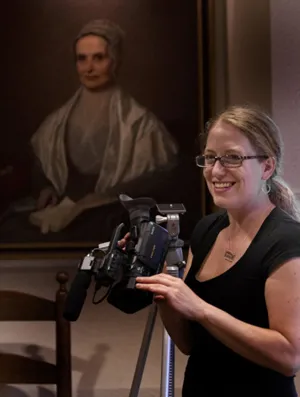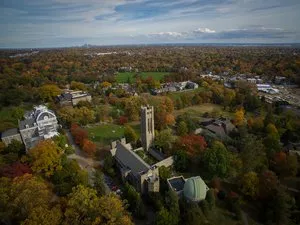Multimedia Artist Traces Roots to College Founder and Social Reformer Lucretia Mott

Jenny Breukelman, although neither a Swarthmore alumna nor student, has a special affinity for College founder Lucretia Mott (1793-1880). The differences between the two women are plentiful: Nantucket-born Mott spent much of her working life in Philadelphia while Breukelman hails from Galiano Island, British Columbia. Mott was a Quaker minister and social reformer while Breukelman is a singer, songwriter, and multimedia artist. But for Breukelman, a great-times-four-granddaughter of Mott, the more time she spends learning more about her, the more narrow the distance between them seems.
"I relate to her more now as my grandmother and part of my family than before," says Breukelman, who made her first trip to campus this summer as part of her effort to conduct research in as many Mott-related sites as she could. "I really delved more and saw personal sides of her."
Breukelman recently discovered her Mott connection through her mother and was inspired to investigate her genealogy. "I didn't know that much about her because we were from the other side of the continent," she says. "I just started realizing more and more what an amazing woman she was and started planning a trip to follow her path."
Standing at five feet and weighing 87 and a half pounds, Mott was a diminutive albeit forceful figure in the reform movements of the 19th century who devoted her life to the abolition of slavery, women's rights, school and prison reforms, temperance, peace, and religious tolerance. She lived by her egalitarianism beliefs; her Philadelphia home was a stop on the Underground Railroad. In 1848, she, along with social activist Elizabeth Cady Stanton, helped organize the first women's rights convention in Seneca Falls, N.Y.

No buildings are named after Mott, nor is there public artwork solely dedicated to her. Yet Mott's presence can still be felt at the College. On display at Friends Historical Library (FHL) is an array of Mott's personal belongings including a walnut box circa. 1779, a 19th-century rocking chair, and a foot stool. The Library is home to numerous photos and reams of letters written by her and her family. The library is also dotted with artwork portraying Mott such as a 19th-century plaster bust and a large portrait (above) painted by William Henry Furness, Jr. Even Mott's original tombstone leans against a back wall (a replacement stone marks her grave in Philadelphia's Fair Hill Burial Ground).
Of particular interest to Breukelman was a red oak tree which Mott planted on Nov. 10, 1869, the College's opening day. According to FHL curator Christopher Densmore, the original tree no longer stands but is thought to have existed on or near the site of McCabe Library. A red oak planted in 1919 in memory of the original tree now stands a short distance from McCabe.
During her campus visit, Breukelman shot footage of the tree and the FHL items for a short, animated film,"Talking to Lucretia: A Journey of Knowing My Grandmother." She also plans to include original music in the film and to share it with her family and the Galiano community on a future International Women's Day.
Breukelman sees her journey as not only important for her, but also for her two teenaged children to gain a sense of their rich, family history. "We live in a really tiny place in a forest in Galiano," she says. "I didn't want [my kids'] perspectives to be really small. I wanted them to see there's more. I figured coming here would be valuable and would help explain our roots."



